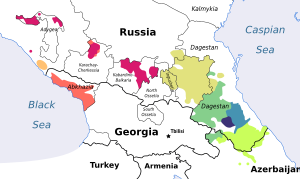| North Caucasian | |||
|---|---|---|---|
| Caucasic | |||
| (controversial) | |||
| Geographic distribution | Caucasus | ||
| Linguistic classification | Proposed language family | ||
| Subdivisions | |||
| Language codes | |||
| ISO 639-5 | ccn | ||
| Glottolog | None | ||
 North Caucasian languages
| |||
The North Caucasian languages, sometimes called simply Caucasic, is a proposed language family consisting of a pair of well established language families spoken in the Caucasus, predominantly in the north, consisting of the Northwest Caucasian family (also called Pontic, Abkhaz–Adyghe, Circassian, or West Caucasian) and the Northeast Caucasian family (also called Nakh–Dagestanian, Caspian or East Caucasian). There are some 34 to 38 distinct North Caucasian languages.[citation needed]
The Kartvelian languages, including Georgian, Zan and Svan, were once known as South Caucasian. However, they are no longer considered related to the North Caucasian languages and are classified as an independent language family.
Some linguists, notably Sergei Starostin and Sergei Nikolaev, believe that the two groups sprang from a common ancestor about five thousand years BCE.[1] However, this proposal is difficult to evaluate, and remains controversial.
North Caucasian has also been given in an automated computational analysis (ASJP 4) by Müller et al. (2013).[2] However, since the analysis was automatically generated, Müller et al. (2013) does not conclude whether the grouping is due to mutual lexical borrowing or genetic inheritance.
- ^ Nikolayev, S., and S. Starostin. 1994 North Caucasian Etymological Dictionary. Moscow: Asterisk Press. Available online.
- ^ Müller, André, Viveka Velupillai, Søren Wichmann, Cecil H. Brown, Eric W. Holman, Sebastian Sauppe, Pamela Brown, Harald Hammarström, Oleg Belyaev, Johann-Mattis List, Dik Bakker, Dmitri Egorov, Matthias Urban, Robert Mailhammer, Matthew S. Dryer, Evgenia Korovina, David Beck, Helen Geyer, Pattie Epps, Anthony Grant, and Pilar Valenzuela. 2013. ASJP World Language Trees of Lexical Similarity: Version 4 (October 2013).